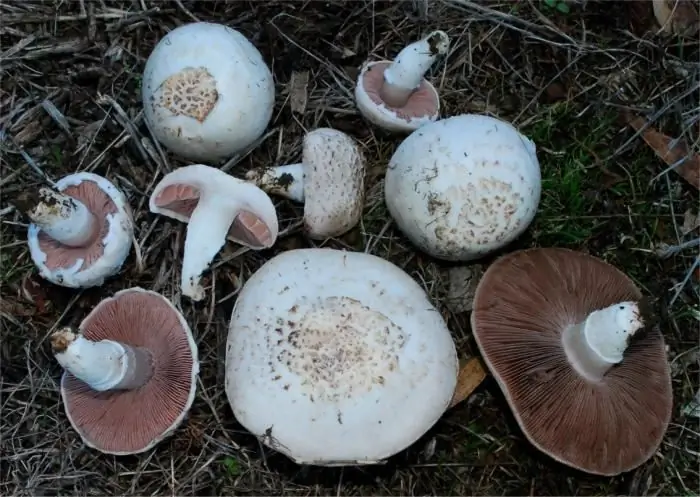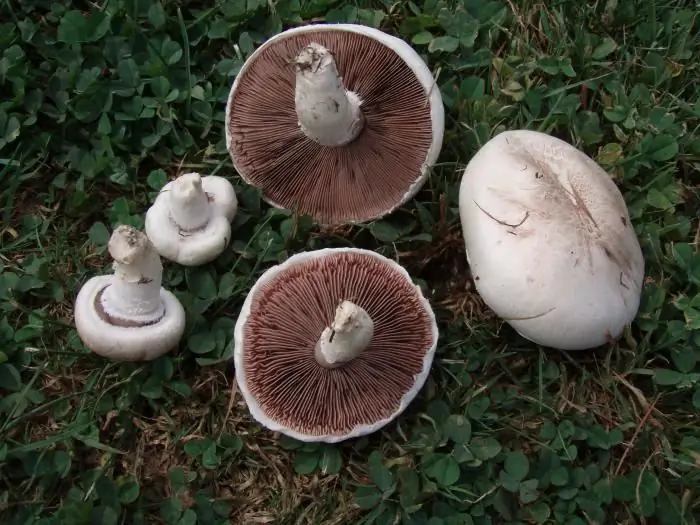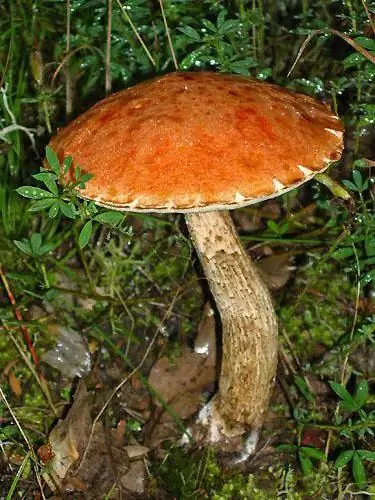- Author Henry Conors [email protected].
- Public 2024-02-12 02:47.
- Last modified 2025-01-23 09:07.
There are many types of mushrooms, but we will talk about champignons (Agaricus). Today it is not at all necessary to collect them in the forest, because in every supermarket they sell beautiful little white mushrooms - a kind of champignon. The French learned to grow them back in the 17th century. Currently, among edible mushrooms in terms of production, this species ranks first in the world.
Champignons in nature
Despite their availability, many tend to get out into nature for mushrooms, because "mushroom hunting" is a very useful, exciting and exciting activity. It allows you to completely escape from everyday problems, to be alone with nature for some time. How interesting it is to find a beautiful mouth-watering fungus among the grass or foliage, and if you're lucky, then the whole family! Mushrooms are ubiquitous, growing in forests, parks, meadows and even on asph alt.
They belong to cap mushrooms. In nature, there are at least 60 of their species, united by common features, but each variety of champignon mushrooms has its ownpeculiarities. Lamellar mushrooms are those that have plates on the underside of the cap. In young champignons, the plates are white, then pinkish, in old ones they become black-brown and black-brown.
This species is also distinguished by the presence of a ring on the stem. The cap and stem are the fruiting body, and the mycelium is in the ground. In the lower layer of the mushroom cap there are spores, with the help of which they multiply, forming a new mycelium. You can also propagate with pieces of mycelium, if you create favorable conditions for this.
Small mushrooms can have not only the familiar spherical shape of the cap, but also bell-shaped, and almost cylindrical. As it grows, its edges gradually move away, and one or two rings form on the leg. The hat continues to open, the plates in its lower part become more noticeable. When opened, it has a semi- or fully prostrate shape.
Edible mushrooms
Let's consider several species most often found on the way by mushroom pickers: forest, meadow, field, two-spore.

Forest (Agaricus silvaticus), sometimes referred to as "blahushka". This variety of champignon can be found in coniferous forests from mid-summer to October, especially on ant heaps. Despite the pleasant taste, it is rarely harvested. Many are frightened off by the fact that at the break the flesh becomes brownish-red.
In young mushrooms, the stem is high, with a white ring, which may fall off in old specimens. The cap is ovoid, then becomesconvex, shaped like a bell, later - flat-prostrate. It has brown fibrous scales.

Meadow (common, stove), Latin name - Agaricus campestris. This variety of champignon is known even to city dwellers, as it is found not far from houses - in gardens, parks. He prefers well-fertilized soil, can grow in pastures, in cattle walking areas. The mushroom is tasty and very productive, grows in large groups.
The hat is white, first it has a spherical shape, then convex, then flat. The plates are pink, gray-brown in mature mushrooms. The flesh is white and elastic, turning pink on the cut. As it grows, the "skirt" that connects the edges of the cap to the stem separates and remains in the form of a membranous ring at the top of the stem.

Field (Agaricus arvensis). This species is the closest relative of the meadow, but many believe that its taste is much better. It has a special, very pleasant smell and is one of the largest among champignons. In some instances, the weight is up to 300 g, and the diameter of the hat reaches 20 cm.
Young mushrooms have an egg-shaped cap, which gradually acquires a flat-convex shape, with a silky skin, when touched, the color changes to yellowish. There is a two-layer ring on the stem, and characteristic yellow protrusions stand out on the lower layer. The plates, as the fungus ages, change color from pinkish to dark brown.
Double-spored (Agaricus bisporus) is a well-known variety of champignon, widely cultivated in artificial conditions.
False mushrooms
Mushroom pickers quite often, due to inexperience, collect a conditionally poisonous (false) variety of champignon and throw it into a basket with other mushrooms. Although eating them is not fatal, it can cause a lot of trouble. Even after heat treatment, toxic substances remain in them, causing poisoning, accompanied by intestinal disorders, vomiting, and colic.

Most often two varieties of champignons are confused with edible mushrooms, the photos of which you see. Yellow-skinned mushroom (Agaricus xanthodermus) is found both in open places and among the grass. This inedible species has a white cap, often with grey-brown spots.
The pulp, in accordance with the name, instantly turns yellow when cut. The lower part of the stem is also yellow, sometimes even orange. This species, due to the bell-shaped hat, is often confused with the field. In addition to the color of the flesh, it can be distinguished by a very unpleasant odor, which increases with frying.

Squamous, variegated, scaly mushroom (Agaricus Placomyces) is another inedible mushroom found in mixed and coniferous forests. Its hat is greyish-brown, with a dark spot in the center, covered with scales. The unpleasant smell of carbolic acid betrays the inedibility of this species.
Sometimes flat-cap champignon is confused with forest mushroom, but as we alreadywe know that in the forest species the smell is pleasant and the flesh on the cut slowly turns red, while in the variegated species it turns yellow and gradually turns brown.
Very often, inexperienced mushroom pickers cannot distinguish young champignons from similar, but deadly poisonous white fly agaric and pale grebe. They are similar in hats, and plates, and rings on legs.
It must be remembered that the difference is clearly visible only in adult specimens: in fly agaric and pale grebe, unlike edible champignons, the color of the plates remains light. Find an adult mushroom and carefully inspect the bottom of the cap. Another simple way to check: when pressed, the color of the pulp of a poisonous mushroom does not change.
Photo 1 - forest champignon;
Photo 2 - meadow champignon;
Photo 3 - field champignon;
Photo 4 - yellow-skinned champignon;
Photo 5 - flat cap champignon.






